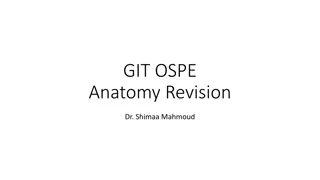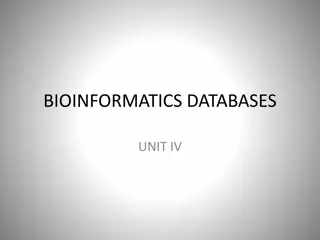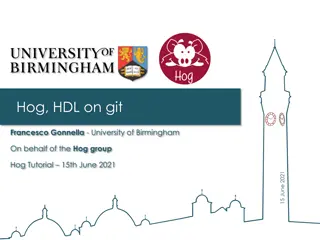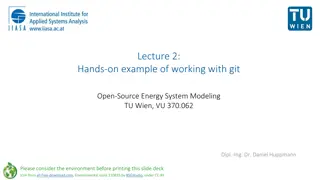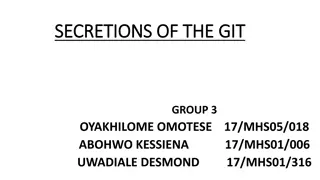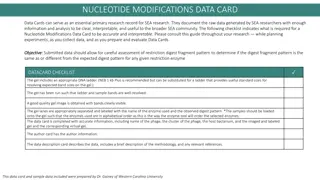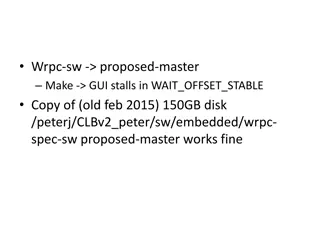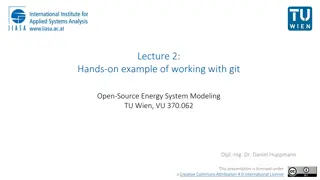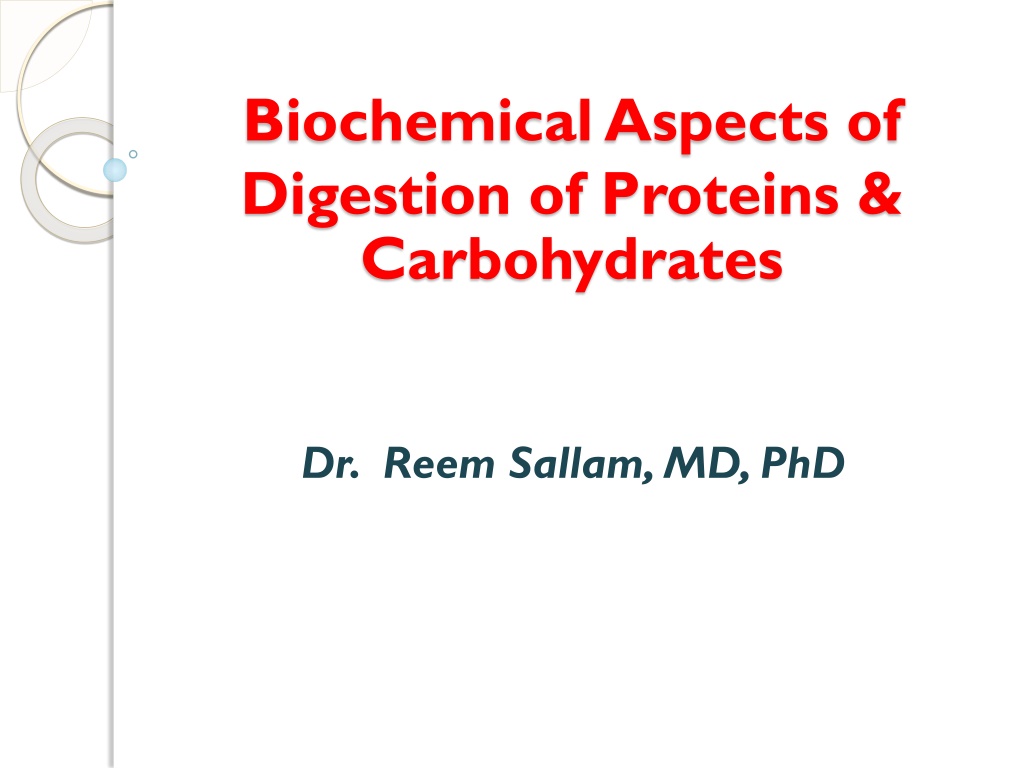
Biochemical Aspects of Protein and Carbohydrate Digestion by Dr. Reem Sallam, MD, PhD
Explore the intricate process of protein and carbohydrate digestion as presented by Dr. Reem Sallam, MD, PhD. Understand the enzymes, organs involved, and clinical implications of defective digestion. Dive into the biochemistry of dietary proteins and their breakdown into absorbable amino acids for optimal health.
Download Presentation

Please find below an Image/Link to download the presentation.
The content on the website is provided AS IS for your information and personal use only. It may not be sold, licensed, or shared on other websites without obtaining consent from the author. Download presentation by click this link. If you encounter any issues during the download, it is possible that the publisher has removed the file from their server.
E N D
Presentation Transcript
Biochemical Aspects of Digestion of Proteins & Carbohydrates Dr. Reem Sallam, MD, PhD
OBJECTIVES By the end of this lecture, the student should be able to: Understand the overall process of dietary protein and carbohydrates digestion, the organs involved, the enzymes required, and the end products. Implement the basic science knowledge of the process of protein & carbohydrates digestion to understand the clinical manifestations of diseases that involve defective protein or carbohydrates digestion &/or absorption
Biochemical Aspects of Digestion of Dietary Proteins
Protein Digestion Dietary proteins constitute 70-100 g/day Proteins are generally too large to be absorbed by the intestine. They must, therefore, be hydrolyzed to their constituent amino acids, which can be absorbed
The source of proteolytic enzymes responsible for degrading dietary proteins 1. The stomach 2. The pancreas 3. The small intestine 1 & Rennin 2 3
1- Digestion of Proteins by Gastric Secretion The gastric juice contains 3 components important for protein digestion: 1. Hydrochloric acid 2. Pepsin 3. Rennin (in neonates and infants) Protein digestion by stomach Polypeptides
2- Digestion of Proteins by Pancreatic enzymes The digestion in small intestine is hormonally controlled. Two small peptide hormones are released from cells of the upper part of small intestine: 1.Cholecystokinin (CCK) 2.Secretin
Hormonal control of digestion in small intestine: Cholecystokinin (CCK): 1. Secretion of pancreatic enzymes Bile secretion Slow release of gastric contents 2. 3. Secretin: Release of watery solution rich in bicarbonate by pancreas
The gut hormones: The gut hormone Stimulus for secretion Effects The presence of partially digested proteins (& lipids) in the upper small intestine 1. Stimulates the release of pancreatic digestive enzymes 1- Cholecystokinin (CCK) 2. Stimulates the contraction of the gall bladder & release of bile 3. Decreases gastric motility slower release of gastric contents into the small intestine
The gut hormones: continued The gut hormone Stimulus for secretion Effects Low pH of the chyme entering the intestine Stimulates the pancreas to release a watery solution rich in bicarbonate to neutralize the pH of the intestinal contents (to reach the optimum pH for digestive activity by pancreatic enzymes) 2- Secretin
Pancreatic enzymes for Digestion of Proteins The pancreatic secretion contains a group of pancreatic proteases Each of these enzymes has different specificity for the cleavage sites These proteases are synthesized and secreted as inactive zymogens
Activation of Pancreatic enzymes Enteropeptidase activates trypsinogen: It converts trypsinogen (inactive) into trypsin (active) Trypsin pancreatic zymogens (including itself) then activates all the other Enteropeptidase is an enzyme synthesized by, and present on the luminal surface of intestinal mucosal cells (the brush border membrane)
Pancreatic enzymes, continued Zymogen Trypsinogen Active enzyme Trypsin (endopeptidase) Activating enzyme 1- Enteropeptidase 2-Trypsin (autocatalysis) Trypsin Chymotrypsinogen Chymotrypsin (endopeptidase) Elastase (endopeptidase) Proelastase Trypsin Trypsin Procarboxypeptid- ases Carboxypeptidases (exopeptidases)
3- Digestion of proteins in small intestine Oligopeptides that result from the action of pancreatic proteases are cleaved into free amino acids and smaller peptides (di- & tri-peptides) by intestinal aminopeptidase (an exopeptidase on the luminal surface of the intestine)
Absorption of digested proteins Intestinal lumen Amino Acids Di- & tripeptides Enterocyte Amino Acids Di- & tripeptides peptidases Amino Acids Amino acids Amino Acids in portal vein to the liver
Abnormalities in protein digestion Pancreatic insufficiency, e.g., chronic pancreatitis, cystic fibrosis, surgical removal of the incomplete digestion & absorption of lipids & proteins appearance of lipids (steatorrhea) & undigested proteins in the feces pancreas abnormal
Celiac Disease (Celiac sprue) It is a disease of malabsorption resulting from damage to the small intestine in response to ingestion of gluten immune-mediated Gluten is a protein found in wheat, rye,and barley
Biochemical Aspects of Digestion of Dietary Carbohydrates
Carbohydrates Digestion Carbohydrates digestion is rapid: Generally completed by the time the gastric contents reach the junction of the duodenum & jejunum. Sites for digestion of dietary carbohydrates: The mouth The intestinal lumen
Dietary carbohydrates Mainly: Polysaccharides: Starch from plant origin Glycogen from animal origin Cellulose from plant origin Oligosaccharides Disaccharides: Sucrose Lactose Maltose o Monosaccharides: Little amounts Contain (1 4) & (1 6) bonds Contains (1 4) bonds
Enzymes for Digestion of Dietary Carbohydrates -amylase (Both salivary & pancreatic): Substrate: Polysaccharides Disaccharidases (Intestinal): Substrate: Disaccharides Isomaltase & (1,6) glucosidase (Intestinal): Substrate: Branch points of oligo- and di-saccharides
Effect of -Amylase on Glycogen Hydrolysis of: (1,4) glycosidic bonds Products: Mixture of short oligosaccharides (both branched & unbranched) Disaccharides: Maltose and isomaltose
Enzymes for Digestion of Dietary Carbohydrates CONT D No dietary carbohydrate digestion occurs in the stomach (the high acidity of the stomach inactivates the salivary amylase). Pancreatic amylase continues the process of starch & glycogen digestion in the small intestine (Secreted by pancreas and worked in small intestine)
Serum level of -Amylases Normal level in serum: 25 -125 U/L The clinical significance of rising circulating levels of -amylase activity: Diagnosis of acute pancreatitis (damage of pancreatic cells release & activation of the intracellular enzymes into the blood) Its level starts to rise within few hours Reaches a peak within 12- 72 hours Then returns to normal within few days
Final digestion of carbohydrates by intestinal enzymes in the small intestine Enzymes: Secreted by & remain associated with the luminal side of the brush border membranes of the intestinal mucosal cells Location of their action: the mucosal lining of the jejunum They include: Disaccharidases (1,6) Glucosidase (for branched oligosaccharides)
Intestinal disaccharidases Enzyme Isomaltase Maltase Substrate Product isomaltose maltose 2 Glucose 2 Glucose Sucrase sucrose Glucose & fructose Lactase ( -galactosidase) lactose Glucose & galactose
Digestion of Carbohydrates Dietary cellulose cannot be digested due to the absence of enzyme that can cleave (1-4) bonds. It passes through the GIT largely intact. Despite that, it has several beneficial effects.
Absorption of Monosaccharides by Intestinal Mucosal Cells Location: Duodenum & upper jejunum Insulin is not required for the uptake of glucose by intestinal cells Different monosaccharides have different mechanisms of absorption 1. Facilitated diffusion (GLUT-mediated) 2. Active transport (Energy-dependent): Co-transport with Na+
Absorption of digested carbohydrates Intestinal lumen Glucose & Galactose Fructose Na+-dependent Active transport GLUT -5 Enterocyte Glucose & Galactose Fructose GLUT -2 Monosaccharides in portal vein to the liver
Abnormal digestion of disaccharides (e.g. of lactose) Lactose intolerance (Lactase deficiency) Lactase ( -galactosidase) deficiency Undigested carbohydrate in large intestine osmotic diarrhea. Bacterial fermentation of the undigested compounds in the large intestine CO2, H2gas abdominal cramps, diarrhea & distension (flatulence)
Take home message Digestion of dietary proteins Proteolytic enzymes responsible for digestion of dietary proteins are produced by the stomach, the pancreas & the small intestine. The digestion of proteins in the stomach is the result of the action of HCl, pepsin & rennin Pancreatic proteases are, like pepsin, synthesized and secreted as inactive zymogens
Take home message Digestion of dietary proteins The intestinal digestion of proteins occurs in the small intestine s lumen, on the luminal surface of the small intestine, and is completed intracellularly to produce free amino acids In pancreatic absorption of fat & protein is incomplete steatorrhea & appearance of undigested proteins in the feces insufficiency, the digestion and
Take home message Digestion of dietary carbohydrates Salivary -amylase acts on dietary glycogen & starch in the mouth -amylase Pancreatic polysaccharide digestion in small intestine continues the process of The monosaccharides occur at the mucosal lining of the small intestine by disaccharidases & (1,6) glucosidase final digestive processes of carbohydrates into Dietary cellulose cannot be digested due to the absence of enzyme that can cleave (1-4) bonds, so it passes through the GIT largely intact. Despite that, it has several beneficial effects.
Take home message Digestion of dietary carbohydrates Absorption of the monosaccharides requires specific transporters (GLUTs) Lactose intolerance is due to deficiency of lactase enzyme and causes abdominal cramps, diarrhea & flatulence

